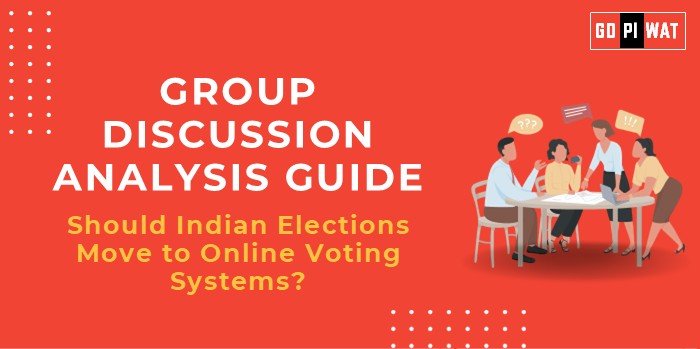📋 Group Discussion Analysis Guide: Should Indian Elections Move to Online Voting Systems?
🌟 Introduction to Online Voting in Indian Elections
Opening Context:
Online voting has become a hot topic globally, with countries like Estonia pioneering e-governance and secure digital voting. In India, where over 900 million voters exist, the idea sparks debates over feasibility and security.
Topic Background:
Online voting promises convenience and increased participation but raises concerns about cybersecurity and digital literacy. India’s previous success with Digital India initiatives, such as UPI and DigiLocker, provides a foundation to explore this option.
📊 Quick Facts and Key Statistics
- 📈 Voter Population: 900+ million eligible voters in India (2024), highlighting the scale of elections.
- 🌐 Internet Penetration: 900 million internet users, but rural connectivity at only 20% (MeitY, 2024).
- ⚠️ Cyberattacks: India recorded 2,138 weekly cyberattacks per organization in 2023, marking a 15% increase from 2022.
- 🌍 Global Example: Estonia uses blockchain for secure online voting, achieving 46.7% turnout online (2023).
🧩 Stakeholders and Their Roles
- 🗳️ Election Commission of India (ECI): Ensures fair and secure election processes.
- 💻 Technology Companies: Develop infrastructure for secure voting platforms.
- 🏛️ Government: Facilitates infrastructure and policies.
- 👥 Citizens: Demand transparency, security, and ease of access.
🏆 Achievements and Challenges
✨ Achievements:
- ✔️ Digital Literacy Growth: Programs like PMGDISHA trained over 6.7 crore rural citizens (2024).
- ✔️ E-Governance Success: Systems like Aadhaar-enabled e-KYC demonstrate feasibility.
⚠️ Challenges:
- 📉 Digital Divide: Rural internet penetration is only 44.2%, limiting accessibility for rural voters.
- ⚠️ Cybersecurity Risks: The AIIMS cyberattack of 2022 underscores vulnerability.
- ❓ Voter Confidence: Concerns about hacking and manipulation can erode trust in online voting systems.
Global Comparisons:
- 🇪🇪 Estonia: Blockchain-based e-voting with high security.
- 🇺🇸 USA: Concerns about Russian interference led to rejection of online voting.
💬 Structured Arguments for Discussion
- Supporting Stance: “Online voting can increase turnout by providing accessibility to NRIs and disabled voters.”
- Opposing Stance: “Cybersecurity threats could undermine trust and outcomes in elections.”
- Balanced Perspective: “Online voting is promising but requires robust digital infrastructure and trust-building measures.”
🗣️ Effective Discussion Approaches
- Opening Approaches:
- 📊 “India’s 900 million voters could benefit from technology, but only 20% rural penetration poses challenges.”
- 🌏 “Estonia’s success shows possibilities, but can India replicate it on a massive scale?”
- Counter-Argument Handling:
- ✔️ Use case studies like the AIIMS cyberattack to address security concerns while suggesting blockchain and AI solutions.
📈 Strategic Analysis of Strengths and Weaknesses
📊 SWOT Analysis:
- ✔️ Strengths: Improved accessibility, efficiency, and potential for transparency.
- ❌ Weaknesses: Cybersecurity risks, lack of digital literacy.
- 💡 Opportunities: Integrate AI and blockchain; bridge the rural-urban divide.
- ⚠️ Threats: Hacking and misinformation campaigns.
🏫 Connecting with B-School Applications
Real-World Applications:
- 📝 Explore topics in operations management, cybersecurity policy frameworks, and digital transformation projects.
Sample Interview Questions:
- ❓ “What are the key enablers for online voting in India?”
- ❓ “Discuss cybersecurity implications of online voting.”
Insights for Students:
- 📚 Policy formulation and implementation in governance.
- 📖 Explore user-centric design in e-governance systems.


